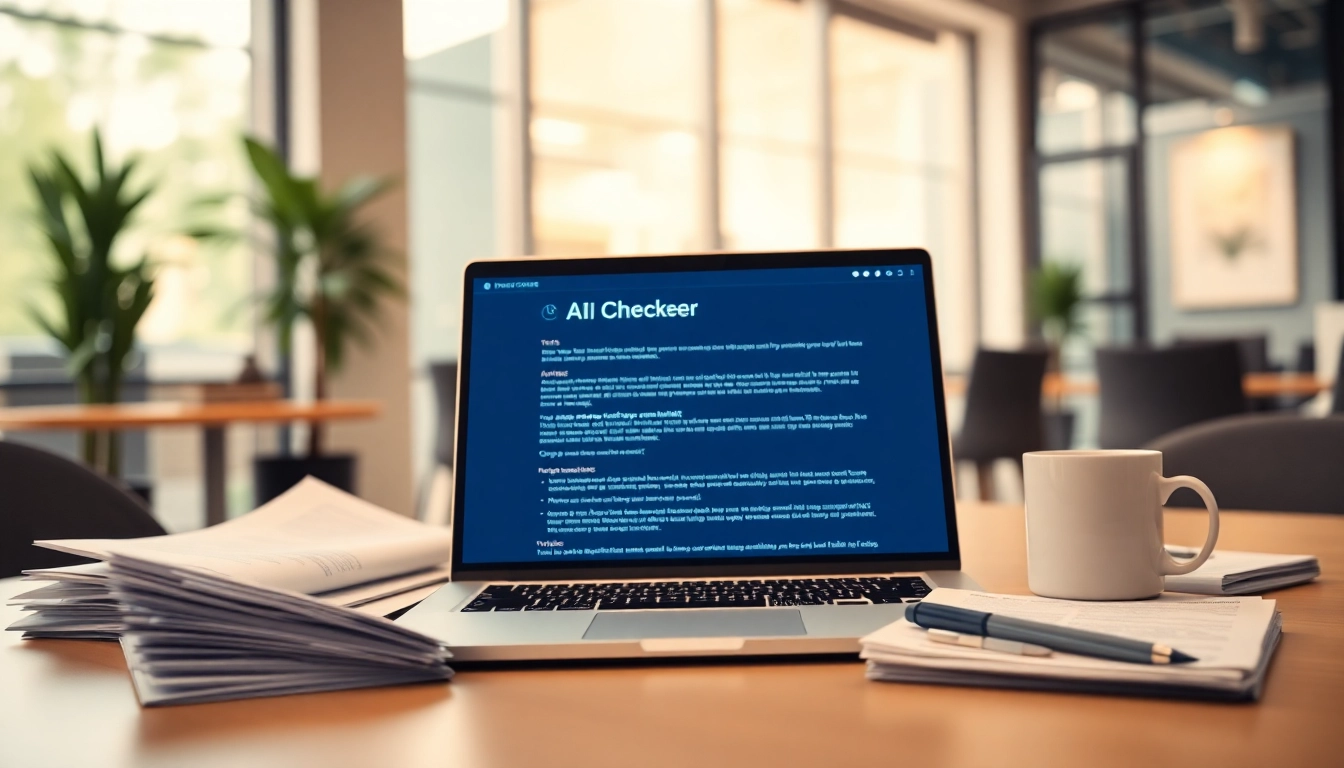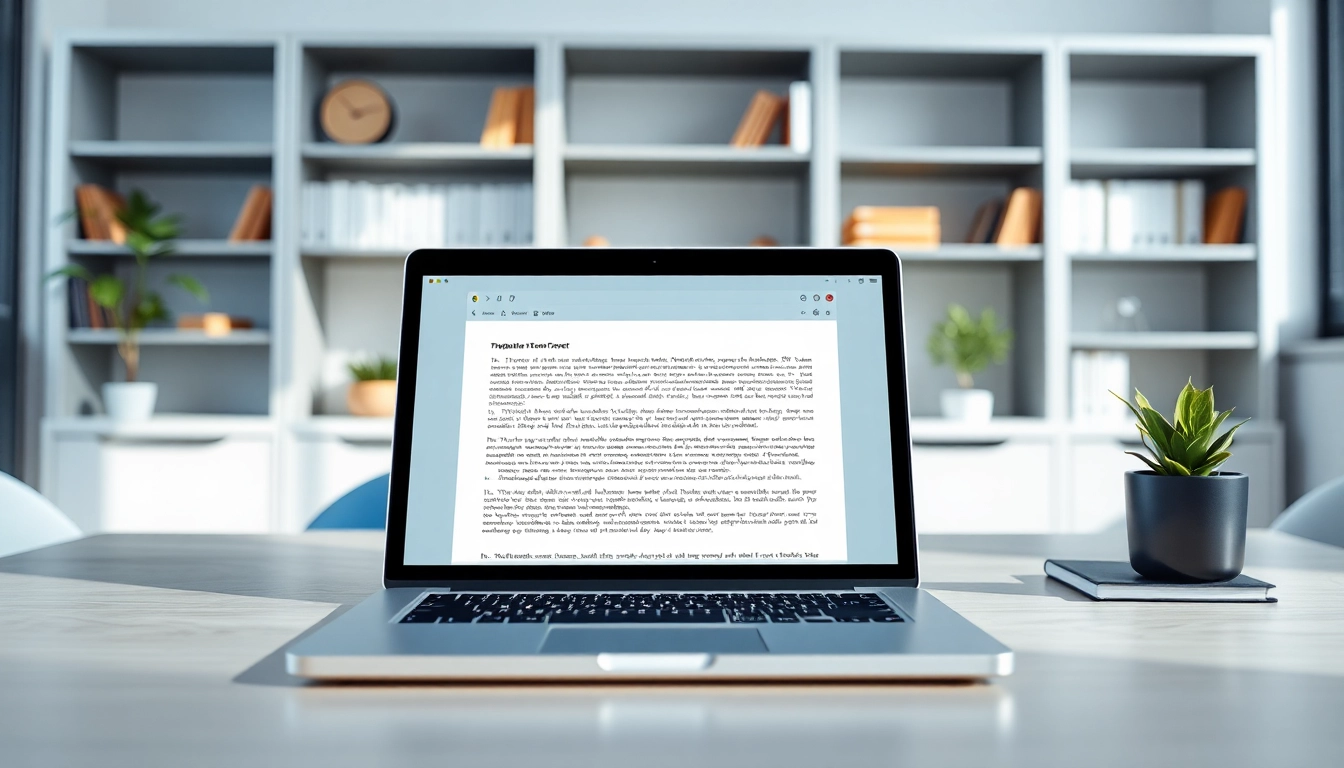Understanding AI Checkers
What is an AI Checker?
An ai checker is a sophisticated tool designed to analyze text and identify content generated by artificial intelligence algorithms. As AI content generation becomes ubiquitous, distinguishing between human-written and AI-generated text has never been more critical. These tools leverage advanced algorithms that scan the text for patterns, structures, and characteristics typical of AI models like GPT-4, ChatGPT, and others. The primary goal of an AI checker is to provide users with insights on the authenticity of their writing, ensuring that text maintains a human touch, particularly in fields such as education, journalism, content marketing, and professional writing.
How AI Checkers Work
AI checkers utilize machine learning and natural language processing (NLP) techniques to assess and evaluate written content. Here’s a breakdown of how they work:
- Data Collection: These tools are trained using vast databases of text samples, both human-written and AI-generated, which help them learn the distinctions between the two styles.
- Text Analysis: When a user inputs text into an AI checker, the system analyzes various linguistic features, including grammar, syntax, and vocabulary usage. It may also evaluate the text’s coherence and structure.
- Pattern Recognition: AI checkers identify specific patterns and markers indicative of machine-generated text, such as repetitive phrases or unusual sentence lengths.
- Scoring System: Most checkers provide a score or percentage indicating the likelihood of the text being AI-generated, alongside detailed feedback on specific sections of the input.
Common Uses of AI Checkers in Writing
Organizations and individuals utilize AI checkers for various purposes, such as:
- Academic Integrity: Educators use AI checkers to ensure students’ work adheres to academic integrity policies and is genuinely authored by the students.
- Content Creation: Writers and content marketers leverage AI checkers to refine and verify the originality of their articles, ensuring they resonate with audiences and escape detection as AI-generated materials.
- Quality Assurance: Businesses utilize AI checkers for proofreading, enhancing the credibility of their communications and marketing materials by ensuring they are human-like and error-free.
Key Features of Top AI Checkers
Accuracy and Reliability Metrics
Accuracy is paramount for any AI checker. Leading tools in the market often highlight their reliability metrics, providing potential users with insightful performance data. Here are some key attributes that define their accuracy:
- Detection Rate: The percentage of AI-generated content accurately identified by the tool.
- False Positive Rate: The frequency at which human-written text is misclassified as AI-generated.
- Benchmarked Performance: Many tools undertake benchmarks against industry standards, showcasing how they stack up against competitors in various tests.
User Interface and Experience
The ease of use of an AI checker greatly influences user experience. A well-designed interface allows users to effortlessly navigate the tool’s features, enhancing overall satisfaction. Key factors include:
- Intuitive Navigation: A clear layout and logical flow enable users to quickly input text and retrieve results.
- Visual Feedback: Effective AI checkers provide visual cues such as graphs or color-coded indicators to depict the analysis results.
- Accessibility: A responsive design ensures compatibility across various devices, ensuring users can access the tool from desktops, tablets, or smartphones.
Support for Multiple AI Models
Given the constantly evolving landscape of AI technology, support for a range of models is crucial for an AI checker’s longevity. Leading tools typically include analysis capabilities for:
- Multiple Generational Models: Including versions like GPT-3, GPT-4, and emerging models like Claude and Gemini.
- Updates and Improvements: Frequent updates to the AI checker’s databases and algorithms ensure compatibility with the latest advancements in AI technology.
Comparing Popular AI Checkers
ZeroGPT vs. Grammarly: A Feature Comparison
Both ZeroGPT and Grammarly are well-respected in the AI detection field but serve slightly different purposes:
- ZeroGPT: Specifically designed as an AI detection tool, ZeroGPT excels in identifying AI-generated content from a variety of platforms, offering insightful feedback on writing quality.
- Grammarly: Traditionally a grammar checker, Grammarly has integrated AI detection features, making it a dual-purpose solution for checking grammar while identifying AI content.
Users often choose based on their specific needs—those looking to primarily detect AI content may lean toward ZeroGPT, while those seeking comprehensive editing alongside grammar checks might prefer Grammarly.
QuillBot vs. Copyleaks: Performance Insights
When comparing QuillBot and Copyleaks, it becomes evident each tool has carved its niche:
- QuillBot: Recognized for its powerful paraphrasing and summarization capabilities, QuillBot also includes an AI checker that quickly identifies potential AI-generated text.
- Copyleaks: This tool is famed for its robustness in plagiarism detection and content originality checks, boasting an impressive accuracy rate for deciphering AI content.
Both platforms cater to users who require thorough insights into content originality but may appeal to distinct target audiences based on additional functionalities.
User Reviews and Ratings Overview
Understanding user experiences plays a vital role in selecting the right AI checker. Overall ratings from users can shed light on performance:
- ZeroGPT: Users commend its accuracy and straightforward approach to detecting AI content, often giving it high ratings for usability.
- Grammarly: Praised for its user-friendly interface, Grammarly’s AI detection capabilities, while sometimes considered secondary to its grammar features, have garnered favorable reviews.
- QuillBot: Users appreciate QuillBot’s flexibility and performance as both a paraphrasing tool and AI checker, elevating its status among competitors.
Best Practices for Using AI Checkers
How to Integrate an AI Checker into Your Workflow
Successfully incorporating an AI checker into your writing routine can streamline your processes and enhance your outputs. Here are some steps to follow:
- Assess Your Needs: Determine what features are most important to you—accuracy, user interface, or multi-model support—before selecting a tool.
- Consistency is Key: Regularly use the AI checker at various stages of your writing process, such as initial drafts, final edits, and content reviews, to ensure comprehensive analysis.
- Gather Feedback: Utilize coworkers or peers to review AI checker results, enhance collaboration, and double-check interpretations to confirm human-like quality.
Tips for Maximizing Accuracy
To achieve the highest reliability from your AI checker, consider the following tips:
- Feed Diverse Text Samples: Test various types of writing, from academic papers to marketing copy, to get a more holistic view of the tool’s capabilities.
- Cross-Reference Results: Utilize multiple AI checkers if feasible, comparing results to identify discrepancies and derive more confident conclusions.
Common Pitfalls to Avoid
While using AI checkers, it is essential to avoid certain common mistakes that can lead to erroneous outcomes or misinterpretations:
- Overreliance on AI Checkers: Always remember that AI tools should augment human judgment, not replace it; the ultimate quality of writing often lies in human creativity.
- Ignoring Feedback: Pay attention to the suggestions provided by the checker and apply them to improve your writing style; otherwise, it may result in repetitive text.
Future of AI Checkers
Trends in AI Content Detection Technology
The landscape of AI detection is continually evolving, with emerging trends shaping its future:
- Improved Algorithms: Advances in AI will lead to more sophisticated algorithms capable of nuanced content analysis and detection, focusing on contextual relevance.
- Real-Time Analysis: As development continues, future AI checkers are likely to offer instant detection capabilities, enabling users to receive feedback as content is created.
Adapting to Evolving AI Models
The competition among AI generation models is fierce. Consequently, AI checkers must remain adaptive, integrating support for new models as they are launched to ensure they are prepared for the changing landscape:
- Continuous Learning: Many AI checkers will likely develop continuous learning capabilities, updating their datasets and algorithms to recognize new patterns and trends.
- Regular Updates: Periodic updates will be crucial for maintaining accuracy rates and ensuring tools remain valuable in an increasingly AI-generated world.
Impact of AI Checkers on Academic and Professional Writing
AI checkers are set to significantly impact the way academic and professional writing is approached, encouraging a blended methodology that values both technology and traditional writing skills:
- Fostering Integrity: As academic integrity becomes increasingly scrutinized, AI checkers will help uphold standards, ensuring submissions remain authentic and trustworthy.
- Enhancing Quality: By integrating AI checkers into writing processes, professionals can produce higher quality, contextually relevant, and engaging content that resonates with audiences.



